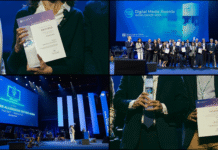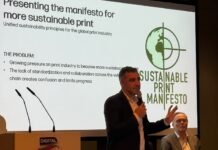Earlier in November, I wrote about the Japan Inkjet Technology Fair and its efforts to foster a community spirit amongst the many inkjet professionals in Japan. This vision also includes a desire to work with international partners, including the Drupa team at Messe Dusseldorf, with next year’s Drupa show likely to dominate the print calendar in 2024.
So Messe Düsseldorf also took a stand at the show with Sabine Geldermann, the director of Drupa, delivering a presentation to a packed conference room. Geldermann told me, “Japan has been so important for Drupa as one of the first nations since 1951 when the first exhibition took place. They are sitting in the driving seat when it comes to inkjet technology and solutions.”
She added, “So we value our partnership here at JITF. This speaks about the importance of Japan. It’s a very dynamic market. And we expect a huge number of visitors from Japan as well as all the exhibitors, so Japan is a key market for us. And this is one of the reasons why we have to be here at JITF.”
Geldermann says that Drupa itself is on track with most of the exhibition space now sold, noting, “We are getting close to the 2016 figures at least as far as the exhibitors side which is important after such a long time.” She says that much has changed in the eight years since the last Drupa, noting, “Covid has hugely driven digital transformation.”
She adds, “The market is continuing to evolve and there are new applications.” This includes a greater emphasis on packaging, from folding carton to flexible films as well as labels. She says that there will also be more industrial printing as well as textiles and interior decoration at Drupa, and that the 3D printing market is also continuing to mature. She concludes, “It’s going to be highly international with many players from all over the world.”

In the first part of this story I wrote mostly about print heads but there were also a lot of ink manufacturers at the JITF event and these led to some interesting conversations.
It’s not often that I come across an entirely new class of inks so the structural inks that Fujifilm showed were quite a surprise. I’ve already covered this in more detail but essentially this ink relies on tiny physical structures within the ink to block certain wavelengths of light rather than colored pigment. Consequently the ink itself is clear but produces very vivid iridescent colors on a black background or more pearl-like effect on white backgrounds.
Toyo inks has been working on increasing the color gamut from its pigments so as to be able to cut the standard process inkset for inkjet inks down to just cyan, magenta and yellow. Fewer colors means less printheads and less complexity for the press design, which in turn should lead to less expensive printing presses as well as easier ink management.
Kazuya Yamashita, general manager of Toyo Color. says that Toyo is not quite there yet but can already reproduce most of the color gamut. The sticking point seems to be the yellow pigment, which is not stable enough yet. He adds, “The shelf life is not good enough. It’s good for toner but not for water-based inkjet.”

DIC also took a table top at the event. Hiroyuki Fukui, manager of the printing material products division of DIC explained that this was the first time the company had participated in such an event, noting, “We don’t normally show our products because we only sell to the printer manufacturers.”
The DIC group has a wide ranging portfolio, including Sun Chemical, but DIC itself only sells UV-curable and water-based inks. The aqueous inks are mainly designed for coated paper and aimed mostly at the publishing market though Fukui notes that “corrugated board is very active in China.” He adds, “It uses resin binder so there’s no need for primer.”
DIC acquired Sensient in 2020 so it also aims at the textile market though Fukui notes: “It’s stable for home decor but not so good for garments.” He adds, “The label market is interesting to us right now. We are talking about how to develop aqueous ink for labels with Sun Chemical.“
He says that they are still observing the flexible film inkjet market, noting, “It’s technically very challenging. And if we are successful then the volume that we can sell is not so big. It’s a limited application. The difficulty in flexible film is the humectant. There are a lot of humectants which makes it difficult to laminate the films. Without humectants the jetting performance is affected so there is a balance that is difficult. If you don’t need a humectant then it’s easier, which is the case for some label applications.”
He continues, “With a high viscosity ink you can have less water and less humectant. If you can use this kind of printhead then we can develop inkjet ink for flexible film. We talked about this with Quantica.” He concluded, “Sun Chemical has a lot of channels to head makers so we can collaborate on this with them.”
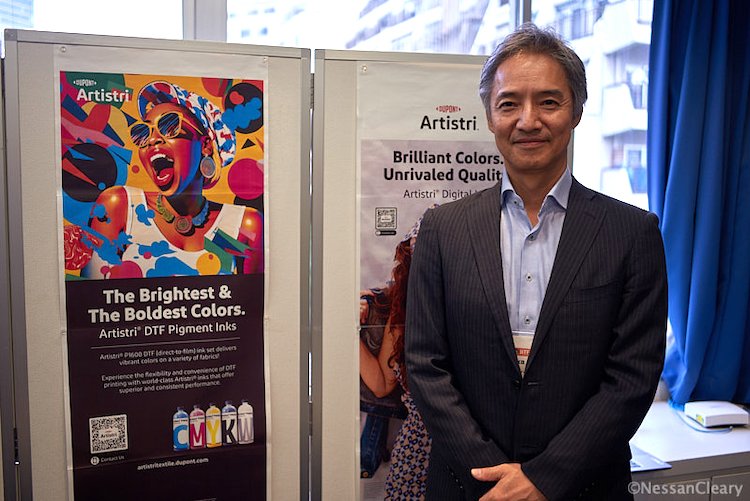
DuPont showed off a number of its textile inks, which can be used as after market inks. However Tatsuya Ogita, regional business leader for Dupont, says that this is a tough sell in Japan because the Japanese market is mainly focused on OEM machine sales.
Ogita says, “DtF image quality is better than DtG because it’s easier to print to a film than a fabric. But the hand feel is not very good.”
He further explains, “T-shirts for events should be more high quality image and they don’t care about the hand feel because they are only wearing it at that event. Or if it’s a very small graphic. But for more usual usage – then DtG is better.”
I also had an interesting conversation with Jason Wu, the founder and CEO of Taiwanese ink maker Sitech, which makes both latex and UV inks. He discussed how some applications for latex ink require more resin in the formulation, which in turn affects the de-cap time for the printheads. This de-cap time can drop from 24 hours for paper-based applications to around 1hr for printing to plastics. He says that Sitech produces some ink for corrugated use, adding, “We have just started in labels because there is a transition from UV to water-based ink.“
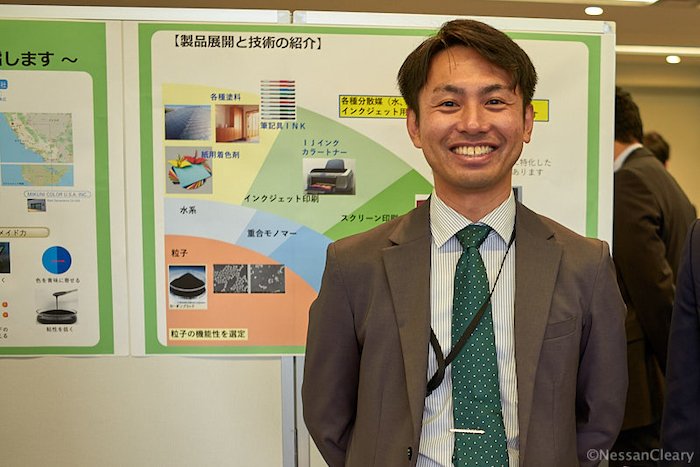
Mikuni Color develops pigment dispersions, which can be used to create color in a number of different products, including inkjet inks. Natsuki Inoue, assistant group leader for R&D of Mikuni Color says that while most companies use inorganic particles, Mikuni is using resins to produce organic dispersions, which have a much higher transfer rate than other dispersions.
Mikuni also makes a dispersion specifically for use with textiles, such as Direct-to-Film inks. Inoue adds that most coatings use silica, noting, “If we use silica it’s inorganic so it produces a very hard finish and is difficult to treat for coating. But our product is organic so it’s easy to use and to coat.”
The European company Kronos also took a table top and talked about dispersions for use in printing inks, though Kronos specializes in producing white pigments. I’ve already covered this in more detail in an earlier story.
Several vendors mentioned electron beam curing, which was briefly popular a few years ago because it is safer for use with food packaging than UV inks. This is because the EB inks do not need a photo-initiator to kickstart the curing process, and it’s the photo-initiator that carries most of the risk of migration from the packaging to the food-stuff. However, the main problem with this approach has always been the relatively high cost of the electron beam lamps.
Nonetheless, there was some interest shown in this at the JITF, which I will cover in the next story. For now it’s worth noting that the ink companies were less keen on this. DIC, for example, has developed EB inks for conventional printing but not for inkjet. Fukui says, “The machines have become bigger and cost a lot so we are now focusing on UV and aqueous.”
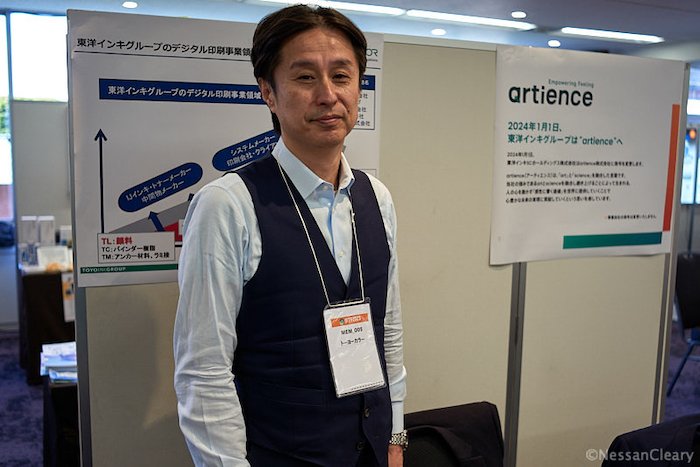
Yamashita says that Toyo has also stopped working on EB inks because water-based inks offer similar safety for food packaging, adding, “And the water-based technology is so advanced now.” As he points out, the problem with water-based inks is the high cost of energy used to dry the prints. He notes, “If the ink suppliers can fix this problem then the water-based ink can be much better than UV or EB. I believe this is feasible in the coming years.”
It’s worth noting that Toyo has already made considerable progress in this area, having worked with Miyakoshi on the development of the MJP30AXF press for flexible film packaging (which is also being sold by Fujifilm, with the Toyo inks, as the FP790.)
However, Yamashita says that water-based inkjet inks for label printing are more of a challenge, “The label printing machines must use both coated paper and films. The paper will soak up the ink, and sometimes they use uncoated paper, such as for wine bottle labels, so the optical density must be high on uncoated stocks. And then there is the Swiss Ordinance and so on. So labels with water-based ink is the most difficult challenge.”
In the final part of this report from the JITF I will cover some of the printer manufacturers and integrators that I talked with at the event. In the meantime, you can find the first part here while the final part is here.
First published in Printing and Manufacturing Journal on 22 November 2023. Republished here by permission.






